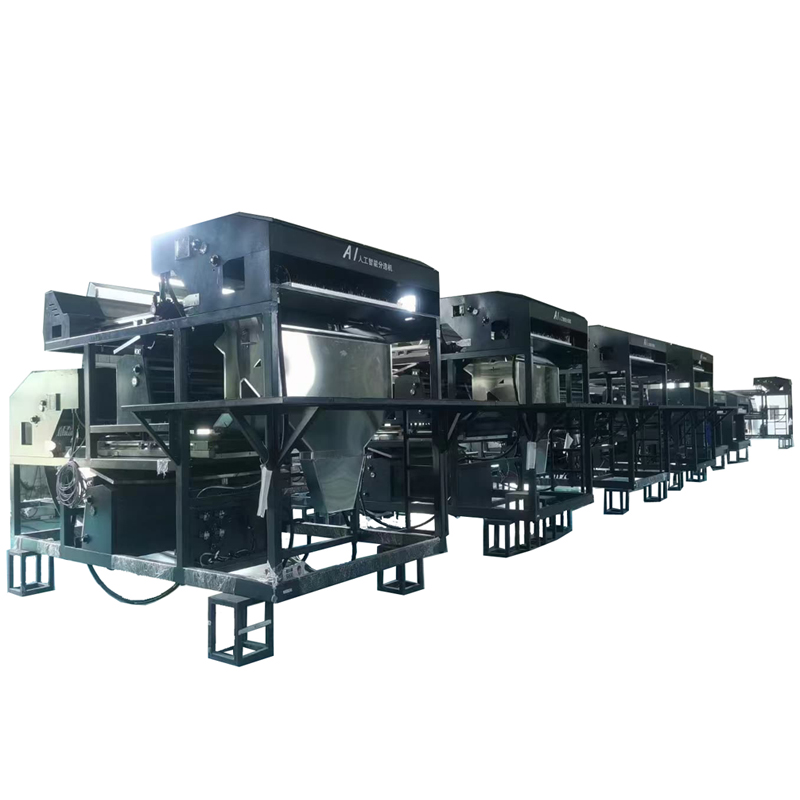Subscribe to our newsletter and always be the first to hear about what is happening.
A few changes in the direction of our mining policy
Jul 24, 2023A few changes in the direction of our mining policy!

The policy direction of mining development depends mainly on two aspects: on the one hand, mineral resources are the important material basis for national economic construction and social development, and the main source of energy (power) and industrial raw materials for human beings. Therefore, the mining industry is an indispensable basic industry for human beings.
At present, China is still in the middle and late stages of industrialization, which is the stage of greater demand for mineral resources. On the other hand, as the people's living standard rises, their demand for better quality of life becomes higher and higher.
The construction of ecological civilization is related to the well-being of the people, the improvement of their quality of life, and the bright prospects for the future of the nation. Therefore, the excellent mining policy must run through such a main line: on the one hand, it should provide reliable resource guarantee for economic and social development, and ensure national resource and energy security; on the other hand, it should satisfy the people's demand for quality of life, especially environmental protection, and it must realize the green development of the mining industry and adapt to the carrying capacity of the ecological and environmental systems through the advanced concepts, correct policy orientation and advanced technological means, and achieve the goal of sustainable development. to achieve the goal of sustainable development. This is the sacred mission and foundation of the mining industry.
From the development trend in recent years, China's policy orientation of the mining industry is presenting changes in the following aspects.
Policy direction of mineral resources management
The revision of the Mineral Resources Law has been initiated. Revised and improved more than ten administrative regulations and departmental rules on geology and mineral management.
In accordance with the Decision on the Cancellation of a Batch of Administrative Permit Matters issued by the State Council on September 22, 2017, the former Ministry of Land and Resources has increased its efforts to simplify and decentralize government, combine management and optimize service reforms in the field of geology and mining, and comprehensively canceled non-administrative permit matters. The cancellation and decentralization of government administrative approvals amounted to 56%.
In the future, the main mining management functions of the natural resources departments will be shifted to "formulating industry standards and norms, strengthening supervision during and after the incident, punishing illegal acts, and maintaining market order".
Reform of the mineral resources royalty system. A new type of mineral resources royalty system has been established, consisting of proceeds from the granting of mining rights, occupancy fees for mining rights, and a fund for the treatment and restoration of the geological environment in mines.
In six provinces (autonomous regions), the Ministry deployed pilot projects for reforming the system for granting mining rights, and explored the implementation of competitive granting of mining rights.
On May 5, the Ministry of Natural Resources issued a notice stating that in order to further promote the structural reform of the coal supply side, eliminate backward production capacity, release high-quality production capacity, improve the structure of coal supply, and maintain a dynamic balance between supply and demand in the market, the "Opinions of the Ministry of Land and Resources on Supporting Iron, Steel and Coal Industries in Achieving Difficulty Relief and Development by Dismantling Overcapacities" stipulates that the approval of the scope of mining areas for coal will stop within three years starting from 2016 and will not be approved by the Ministry of Land and Resources.
Changes in policies on geological exploration
Prior to 2013, the State encouraged geological exploration units to "go out" through risk exploration grants, but in 2013 it announced that it would stop the declaration of overseas projects.
The boundary between the market and the government has been clearly defined, and the government has withdrawn from the commercial geology field. Geological exploration work funded by the central government will further focus on public interest, basic geological surveys and strategic mineral exploration. Local financial resources will also focus on basic and public welfare geological surveys, and the investment in mineral exploration may be further reduced. After the reform of the classification of public institutions, public welfare geological work will be mainly undertaken by the first class of public welfare units, and most of the second class of public welfare and the geosurveying units that have been transferred to enterprises can only engage in commercial geological work. In a sense, this subverts the survival and development mode of previous geological exploration units.
Formal abolition of the qualification of geological exploration. According to the arrangements in the State Council's Negative List for Market Access and the Reform Program for the Mining Rights Granting System, starting from 2018, there will no longer be any qualification requirements for the exploration of any other types of minerals, except for shale gas, oil and gas, rare earths and tungsten mines.
The competent departments of land and resources at all levels will no longer accept applications and carry out approval work for the new establishment, continuation, change and replacement of geological exploration qualifications, nor shall they engage in approval in disguise by transferring them to subordinate institutions and associations for continued approval. This means that as long as your company has the information and technology, you can apply for the first way to obtain the first type of prospecting rights that risk exploration.
Increasing environmental requirements for mineral exploration and extraction
The Ministry of Ecology and Environment has newly promulgated the "Measures for Soil Environment Management of Industrial and Mining Land (for Trial Implementation)", which came into effect on August 1st. The Measures stipulate that industrial and mining enterprises are responsible for environmental protection of soil and groundwater on industrial and mining land, and enterprises causing soil and groundwater pollution on industrial and mining land should take the main responsibility for treatment and remediation. For pollution prevention and control, the key units of new, altered, expanded
After the 18th National Congress, the State has increased its efforts to transform the mode of development, strengthen the construction of nature reserves and the establishment of the national park system, which has put forward clear requirements for the transformation and upgrading of geological exploration work, and the exploration and exploitation of mineral resources in these areas have been suppressed.
In 2016, the State Council added 240 counties to the national key ecological functional zones, increasing the total number of national key ecological functional zones to 676 county-level administrative districts. from 2013 to 2017, the State Council added 100 new national nature reserves, increasing the total number to 463. the State Council has also established the National Nature Reserve System, which is the first national nature reserve in China.
The Supreme People's Court issued judicial interpretations to strengthen the legal constraints on mineral resources exploration and exploitation activities in nature reserves, scenic spots, key ecological functional zones, sensitive and fragile ecological environment zones, and other areas.
In 2017, more and more provinces, such as Inner Mongolia, Qinghai and Hunan, issued documents to steadily push forward the clearance of mining rights in nature reserves; the former Ministry of Land and Resources issued a document to start the cleanup of mining rights in various types of protected areas. The space for mineral exploration and mining is decreasing, the environmental cost of mineral exploration and mining is increasing, and the environmental constraints on mineral exploration and mining are increasing.
Adopting "real money" incentive policies for green mine construction
In March 2017, the former Ministry of Land and Resources, the Ministry of Finance, the Ministry of Environmental Protection and other six departments jointly issued the "Implementation Opinions on Accelerating the Construction of Green Mines", which provides incentives and measures in four areas, including land use, mine use, finance, and finance.
These include: preferential arrangement of green mines for mineral mining indicators; for mining land, after the construction land use procedures in accordance with the law, can take the form of agreement to let, lease or rent before letting; eligible mines can be reduced by 15% tax rate for corporate income tax, etc..
For green mines to meet the standards, will establish a "red list", into the enterprise credit system, enjoy the corresponding incentives. The former Ministry of Land and Resources, in conjunction with relevant departments, will assess the progress and effectiveness of annual green mine construction in each province (autonomous regions and municipalities), and link the progress of green mine construction to the annual land planning targets.

Adoption of differentiated mining land use policies
--In 2005, the former Ministry of Land and Resources (MLR) approved the pilot reform of the mining land use method for the Pingguo Bauxite Mine in Guangxi, and in 2009, the former MLR conducted a stage-by-stage acceptance of the pilot reform of the mining land use method for the Pingguo Bauxite Mine in Guangxi, and in 2011, the former MLR expanded the pilot mining land use method and approved the pilot mining land use method for the Phosphate Mine in Yunnan, the Coal Mine in Shanxi, and the Ordos Mine in Inner Mongolia. Coal and four other pilot areas in Inner Mongolia, including Erdos and Liaoning.
In July 2016, the former Ministry of Land and Resources (MLR), together with four ministries and commissions, issued the "Guiding Opinions on Strengthening the Restoration and Comprehensive Management of the Mining Geological Environment", which involves the reform of the management of mining land has been reflected.
The Opinions clearly stated that land use policies should be improved, and differentiated and targeted land use policies should be established according to different types of mines and development methods.
Through a series of exploration and practice, China's mining land problems can be gradually clarified, the relevant policies can be adjusted and improved.
Regarding the pilot policy of saving and intensive use of mining temporary land, the former Ministry of Land and Resources said that shallow surface open-pit mines, done within five years, according to the pilot go, not done go through the normal reporting and approval procedures, the nature of the pilot period, the use of the land does not change, not as illegal land use. At the same time, it is necessary to follow the tripartite consent policy, that is, the local county government, residents and mining enterprises are in favor.
On the characteristics and direction of the mining land policy, the former Ministry of Land and Resources, the relevant departments and bureaus have said in an interview with reporters, mining enterprises should figure out the landing point of the policy, understanding, grasp and use the existing policy. The characteristics and direction of mining land policy in recent years include six aspects.

First, the land supply policy and national industrial policy, national development planning is closely linked, in recent years and the national supply-side reform "three to a complement a drop", that is, to go to production capacity, inventory, lever, cost reduction, fill short boards of the five tasks of the general direction of consistency, the state encourages the type of industry, the supply of land is naturally relatively loose. Secondly, land supply indicators and supply standards are different for each industry, such as increasing the approval of land for clean energy.
Thirdly, the rights to land supply methods (allocation, transfer and leasing) rest with the local government where the enterprise is located, with different rights for different land supply methods (e.g., leasing cannot be financed).
Fourthly, in terms of the number of years of land supply, it is stipulated that the granting of land shall not exceed 50 years, and enterprises need to carry out detailed calculations according to their own development plans and cost-bearing capacity in order to determine the reasonable amount of land to be acquired.
Fifth, there is a minimum standard for land price, such as the land price in the western region is 70% of the minimum price standard.
Sixth, for obtaining temporary land, do not find another way (such as pulling strings), but to grasp and use the existing policy.
For a period of time, there are more regulations involving mine land reclamation and mine geo-environmental restoration and management, involving many departments such as land, environmental protection, forestry, water conservancy, etc. There are overlapping places in the regulations, and some of the same contents are even contradictory and fights in different regulations.
After the reorganization of the Ministry of Natural Resources, it is expected that the Land Reclamation Program and the Mining Geological Environment Restoration and Governance Program will be merged into one, and the new regulations will comply with the spirit of simplifying administration and decentralization without reducing the relevant principles, so that the land remediation fees paid by enterprises can be withdrawn and used for the corresponding restoration and governance.

Sound resource development revenue distribution mechanism
Pursue the core values of inclusion, sharing and harmony in mining development. Relevant parties are implementing a project to benefit the people by improving the mechanism for distributing the proceeds from resource development, further tilting it in favor of the places of origin, and exploring the reform of resource proceeds in impoverished areas to compensate the indigenous residents.
At the same time, they are advocating the fulfillment of social responsibility by enterprises, the establishment of harmonious mining areas, the construction of a mechanism for sharing the interests of mines and the people in the mining areas, and the encouragement of mining enterprises to invest in local social welfare undertakings, so as to increase the sense of gain of the local people.
Accelerate the institutional construction of international cooperation in the mining industry
Further promoting cooperation and exchanges and deepening international cooperation in mineral exploration and development require transparent and stable mining policies. Relevant departments are formulating or improving policies and regulations to encourage foreign investment in China's mining industry, actively implementing pilot free trade zones and relevant bilateral and multilateral free trade arrangements, exploring the establishment of a pre-entry national treatment plus negative list management system, relaxing investment areas and simplifying investment procedures, so as to create a favorable environment for foreign investment in the mining industry.
At the same time, the relevant departments are strengthening exchanges and docking with other countries on management policies, technical standards and industry norms in the mining sector, with a view to eliminating the phenomenon of "glass doors" that exist to varying degrees in the market for mining rights, investment and financing in the mining sector, trade in mining products, environmental access and employment, opposing trade protectionism and reducing systemic costs, and promoting the liberalization and facilitation of investment in the mining sector. Oppose trade protectionism, reduce systemic costs, promote the liberalization and facilitation of mining investment, and provide institutional safeguards for international cooperation in the mining industry.
It needs to be pointed out that, at present, China's mining industry is, on the whole, large but not strong, and at the same time, the long-accumulated rigidity of the institutional mechanism of the mining industry, the tightening of resource constraints, the prominence of ecological problems, the increase in people's livelihoods, and other contradictions and problems are becoming more and more pronounced, and the traditional mode of development has become unsustainable.
In the economic development into a new normal, the central government has incorporated the construction of ecological civilization into the overall layout of the "five-in-one", and put forward the construction of "beautiful China" and the development concept of "innovation, coordination, greenness, openness and sharing". "Under the background of the development concept, we should seize the favorable opportunity to promote the supply-side structural reform, grasp the changes in our mining policy, promote industrial transformation and upgrading, promote the construction of green mines, and realize the fundamental transformation of the development mode of the mining industry.
At the same time, we should grasp the new changes and trends in the development of the mining industry, and promote China's mining industry to realize the medium-high speed growth to the medium-high level, to form a new competitive advantage, and to change from a large mining country to a strong mining country.
------------------------------------- Note: This article is from Mining World